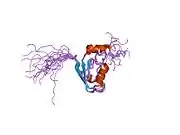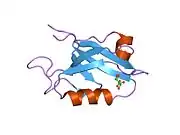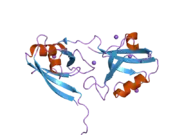Disks large homolog 3 (DLG3) also known as neuroendocrine-DLG or synapse-associated protein 102 (SAP-102) is a protein that in humans is encoded by the DLG3 gene.[5][6] DLG3 is a member of the membrane-associated guanylate kinase (MAGUK) superfamily of proteins.
Interactions
DLG3 has been shown to interact with:
References
- 1 2 3 GRCh38: Ensembl release 89: ENSG00000082458 - Ensembl, May 2017
- 1 2 3 GRCm38: Ensembl release 89: ENSMUSG00000000881 - Ensembl, May 2017
- ↑ "Human PubMed Reference:". National Center for Biotechnology Information, U.S. National Library of Medicine.
- ↑ "Mouse PubMed Reference:". National Center for Biotechnology Information, U.S. National Library of Medicine.
- ↑ Stathakis DG, Lee D, Bryant PJ (Aug 1998). "DLG3, the gene encoding human neuroendocrine Dlg (NE-Dlg), is located within the 1.8-Mb dystonia-parkinsonism region at Xq13.1". Genomics. 49 (2): 310–3. doi:10.1006/geno.1998.5243. PMID 9598320.
- ↑ "Entrez Gene: DLG3 Discs, large homolog 3 (neuroendocrine-dlg, Drosophila)".
- ↑ Makino K, Kuwahara H, Masuko N, Nishiyama Y, Morisaki T, Sasaki J, Nakao M, Kuwano A, Nakata M, Ushio Y, Saya H (May 1997). "Cloning and characterization of NE-dlg: a novel human homolog of the Drosophila discs large (dlg) tumor suppressor protein interacts with the APC protein". Oncogene. 14 (20): 2425–33. doi:10.1038/sj.onc.1201087. PMID 9188857. S2CID 6554126.
- 1 2 3 4 Lim IA, Hall DD, Hell JW (Jun 2002). "Selectivity and promiscuity of the first and second PDZ domains of PSD-95 and synapse-associated protein 102". J. Biol. Chem. 277 (24): 21697–711. doi:10.1074/jbc.M112339200. PMID 11937501.
- ↑ Masuko N, Makino K, Kuwahara H, Fukunaga K, Sudo T, Araki N, Yamamoto H, Yamada Y, Miyamoto E, Saya H (Feb 1999). "Interaction of NE-dlg/SAP102, a neuronal and endocrine tissue-specific membrane-associated guanylate kinase protein, with calmodulin and PSD-95/SAP90. A possible regulatory role in molecular clustering at synaptic sites". J. Biol. Chem. 274 (9): 5782–90. doi:10.1074/jbc.274.9.5782. PMID 10026200.
- 1 2 3 Sans N, Prybylowski K, Petralia RS, Chang K, Wang YX, Racca C, Vicini S, Wenthold RJ (Jun 2003). "NMDA receptor trafficking through an interaction between PDZ proteins and the exocyst complex". Nat. Cell Biol. 5 (6): 520–30. doi:10.1038/ncb990. PMID 12738960. S2CID 13444388.
- 1 2 Irie M, Hata Y, Takeuchi M, Ichtchenko K, Toyoda A, Hirao K, Takai Y, Rosahl TW, Südhof TC (Sep 1997). "Binding of neuroligins to PSD-95". Science. 277 (5331): 1511–5. doi:10.1126/science.277.5331.1511. PMID 9278515.
- ↑ Inanobe A, Fujita A, Ito M, Tomoike H, Inageda K, Kurachi Y (Jun 2002). "Inward rectifier K+ channel Kir2.3 is localized at the postsynaptic membrane of excitatory synapses". Am. J. Physiol., Cell Physiol. 282 (6): C1396-403. doi:10.1152/ajpcell.00615.2001. PMID 11997254.
- ↑ Leonoudakis D, Conti LR, Anderson S, Radeke CM, McGuire LM, Adams ME, Froehner SC, Yates JR, Vandenberg CA (May 2004). "Protein trafficking and anchoring complexes revealed by proteomic analysis of inward rectifier potassium channel (Kir2.x)-associated proteins". J. Biol. Chem. 279 (21): 22331–46. doi:10.1074/jbc.M400285200. PMID 15024025.
- ↑ Seabold GK, Burette A, Lim IA, Weinberg RJ, Hell JW (Apr 2003). "Interaction of the tyrosine kinase Pyk2 with the N-methyl-D-aspartate receptor complex via the Src homology 3 domains of PSD-95 and SAP102". J. Biol. Chem. 278 (17): 15040–8. doi:10.1074/jbc.M212825200. PMID 12576483.
- ↑ Kim JH, Liao D, Lau LF, Huganir RL (Apr 1998). "SynGAP: a synaptic RasGAP that associates with the PSD-95/SAP90 protein family". Neuron. 20 (4): 683–91. doi:10.1016/S0896-6273(00)81008-9. PMID 9581761.
Further reading
- Lau LF, Mammen A, Ehlers MD, et al. (1996). "Interaction of the N-methyl-D-aspartate receptor complex with a novel synapse-associated protein, SAP102". J. Biol. Chem. 271 (35): 21622–8. doi:10.1074/jbc.271.35.21622. PMID 8702950.
- Müller BM, Kistner U, Kindler S, et al. (1996). "SAP102, a novel postsynaptic protein that interacts with NMDA receptor complexes in vivo". Neuron. 17 (2): 255–65. doi:10.1016/S0896-6273(00)80157-9. PMID 8780649.
- Takeuchi M, Hata Y, Hirao K, et al. (1997). "SAPAPs. A family of PSD-95/SAP90-associated proteins localized at postsynaptic density". J. Biol. Chem. 272 (18): 11943–51. doi:10.1074/jbc.272.18.11943. PMID 9115257.
- Makino K, Kuwahara H, Masuko N, et al. (1997). "Cloning and characterization of NE-dlg: a novel human homolog of the Drosophila discs large (dlg) tumor suppressor protein interacts with the APC protein". Oncogene. 14 (20): 2425–33. doi:10.1038/sj.onc.1201087. PMID 9188857. S2CID 6554126.
- Irie M, Hata Y, Takeuchi M, et al. (1997). "Binding of neuroligins to PSD-95". Science. 277 (5331): 1511–5. doi:10.1126/science.277.5331.1511. PMID 9278515.
- Kim JH, Liao D, Lau LF, Huganir RL (1998). "SynGAP: a synaptic RasGAP that associates with the PSD-95/SAP90 protein family". Neuron. 20 (4): 683–91. doi:10.1016/S0896-6273(00)81008-9. PMID 9581761.
- Butz S, Okamoto M, Südhof TC (1998). "A tripartite protein complex with the potential to couple synaptic vesicle exocytosis to cell adhesion in brain". Cell. 94 (6): 773–82. doi:10.1016/S0092-8674(00)81736-5. PMID 9753324.
- Garcia EP, Mehta S, Blair LA, et al. (1998). "SAP90 binds and clusters kainate receptors causing incomplete desensitization". Neuron. 21 (4): 727–39. doi:10.1016/S0896-6273(00)80590-5. PMID 9808460.
- Masuko N, Makino K, Kuwahara H, et al. (1999). "Interaction of NE-dlg/SAP102, a neuronal and endocrine tissue-specific membrane-associated guanylate kinase protein, with calmodulin and PSD-95/SAP90. A possible regulatory role in molecular clustering at synaptic sites". J. Biol. Chem. 274 (9): 5782–90. doi:10.1074/jbc.274.9.5782. PMID 10026200.
- Kuwahara H, Araki N, Makino K, et al. (1999). "A novel NE-dlg/SAP102-associated protein, p51-nedasin, related to the amidohydrolase superfamily, interferes with the association between NE-dlg/SAP102 and N-methyl-D-aspartate receptor". J. Biol. Chem. 274 (45): 32204–14. doi:10.1074/jbc.274.45.32204. PMID 10542258.
- Nagase T, Ishikawa K, Kikuno R, et al. (2000). "Prediction of the coding sequences of unidentified human genes. XV. The complete sequences of 100 new cDNA clones from brain which code for large proteins in vitro". DNA Res. 6 (5): 337–45. doi:10.1093/dnares/6.5.337. PMID 10574462.
- Firestein BL, Firestein BL, Brenman JE, et al. (2000). "Cypin: a cytosolic regulator of PSD-95 postsynaptic targeting". Neuron. 24 (3): 659–72. doi:10.1016/S0896-6273(00)81120-4. PMID 10595517.
- Garcia RA, Vasudevan K, Buonanno A (2000). "The neuregulin receptor ErbB-4 interacts with PDZ-containing proteins at neuronal synapses". Proc. Natl. Acad. Sci. U.S.A. 97 (7): 3596–601. doi:10.1073/pnas.070042497. PMC 16285. PMID 10725395.
- Husi H, Ward MA, Choudhary JS, et al. (2000). "Proteomic analysis of NMDA receptor-adhesion protein signaling complexes". Nat. Neurosci. 3 (7): 661–9. doi:10.1038/76615. hdl:1842/742. PMID 10862698. S2CID 14392630.
- Inagaki S, Ohoka Y, Sugimoto H, et al. (2001). "Sema4c, a transmembrane semaphorin, interacts with a post-synaptic density protein, PSD-95". J. Biol. Chem. 276 (12): 9174–81. doi:10.1074/jbc.M009051200. PMID 11134026.
- DeMarco SJ, Strehler EE (2001). "Plasma membrane Ca2+-atpase isoforms 2b and 4b interact promiscuously and selectively with members of the membrane-associated guanylate kinase family of PDZ (PSD95/Dlg/ZO-1) domain-containing proteins". J. Biol. Chem. 276 (24): 21594–600. doi:10.1074/jbc.M101448200. PMID 11274188.
- Russwurm M, Wittau N, Koesling D (2002). "Guanylyl cyclase/PSD-95 interaction: targeting of the nitric oxide-sensitive alpha2beta1 guanylyl cyclase to synaptic membranes". J. Biol. Chem. 276 (48): 44647–52. doi:10.1074/jbc.M105587200. PMID 11572861.
- Lim IA, Hall DD, Hell JW (2002). "Selectivity and promiscuity of the first and second PDZ domains of PSD-95 and synapse-associated protein 102". J. Biol. Chem. 277 (24): 21697–711. doi:10.1074/jbc.M112339200. PMID 11937501.
- Cai C, Coleman SK, Niemi K, Keinänen K (2002). "Selective binding of synapse-associated protein 97 to GluR-A alpha-amino-5-hydroxy-3-methyl-4-isoxazole propionate receptor subunit is determined by a novel sequence motif". J. Biol. Chem. 277 (35): 31484–90. doi:10.1074/jbc.M204354200. PMID 12070168.
This article is issued from Wikipedia. The text is licensed under Creative Commons - Attribution - Sharealike. Additional terms may apply for the media files.










